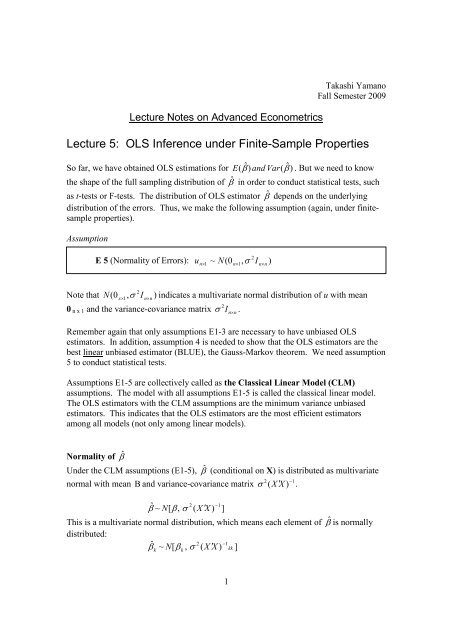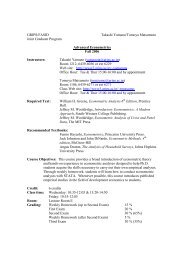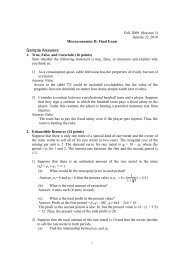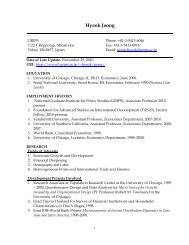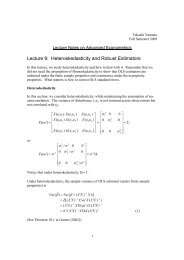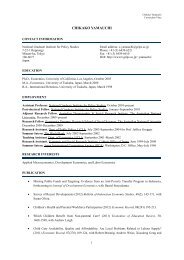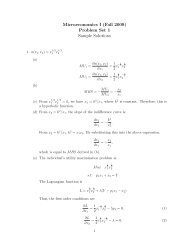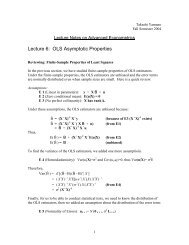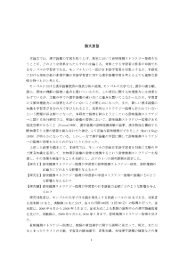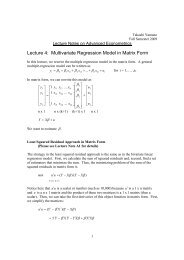Lecture 5: OLS Inference under Finite-Sample Properties
Lecture 5: OLS Inference under Finite-Sample Properties
Lecture 5: OLS Inference under Finite-Sample Properties
Create successful ePaper yourself
Turn your PDF publications into a flip-book with our unique Google optimized e-Paper software.
<strong>Lecture</strong> Notes on Advanced Econometrics<br />
Takashi Yamano<br />
Fall Semester 2009<br />
<strong>Lecture</strong> 5: <strong>OLS</strong> <strong>Inference</strong> <strong>under</strong> <strong>Finite</strong>-<strong>Sample</strong> <strong>Properties</strong><br />
So far, we have obtained <strong>OLS</strong> estimations for E ( ˆ) β and Var(<br />
ˆ β ) . But we need to know<br />
the shape of the full sampling distribution of βˆ in order to conduct statistical tests, such<br />
as t-tests or F-tests. The distribution of <strong>OLS</strong> estimator βˆ depends on the <strong>under</strong>lying<br />
distribution of the errors. Thus, we make the following assumption (again, <strong>under</strong> finitesample<br />
properties).<br />
Assumption<br />
2<br />
E 5 (Normality of Errors): ~ N(0<br />
, I )<br />
u<br />
n× 1 n×<br />
1<br />
σ<br />
n×<br />
n<br />
2<br />
Note that N (0<br />
x× 1,<br />
σ I n × n<br />
) indicates a multivariate normal distribution of u with mean<br />
2<br />
0 n x 1 and the variance-covariance matrix σ I<br />
n × n<br />
.<br />
Remember again that only assumptions E1-3 are necessary to have unbiased <strong>OLS</strong><br />
estimators. In addition, assumption 4 is needed to show that the <strong>OLS</strong> estimators are the<br />
best linear unbiased estimator (BLUE), the Gauss-Markov theorem. We need assumption<br />
5 to conduct statistical tests.<br />
Assumptions E1-5 are collectively called as the Classical Linear Model (CLM)<br />
assumptions. The model with all assumptions E1-5 is called the classical linear model.<br />
The <strong>OLS</strong> estimators with the CLM assumptions are the minimum variance unbiased<br />
estimators. This indicates that the <strong>OLS</strong> estimators are the most efficient estimators<br />
among all models (not only among linear models).<br />
Normality of βˆ<br />
Under the CLM assumptions (E1-5), βˆ (conditional on X) is distributed as multivariate<br />
2 −1<br />
normal with mean Β and variance-covariance matrix σ ( X ′X ) .<br />
ˆ 2 − 1<br />
β ~ N[<br />
β,<br />
σ ( X ′X )<br />
This is a multivariate normal distribution, which means each element of βˆ is normally<br />
distributed:<br />
ˆ 2 −<br />
β ~ N[<br />
β , σ ( X ′ X )<br />
1<br />
kk ]<br />
k<br />
k<br />
]<br />
1
( X X<br />
−1<br />
′ ) kk is the k-th diagonal element of<br />
element of<br />
( X ′X )<br />
−1<br />
as S kk . Then,<br />
( X ′X )<br />
−1<br />
. Let’s denote the k-th diagonal<br />
−1<br />
′<br />
2<br />
σ ( X X )<br />
=<br />
⎛ S<br />
⎜<br />
⎜ .<br />
2<br />
σ ⎜<br />
⎜<br />
⎝ .<br />
11<br />
S<br />
.<br />
.<br />
22<br />
.<br />
.<br />
.<br />
2<br />
. . ⎞ ⎛σ<br />
S11<br />
. . .<br />
⎟ ⎜<br />
2<br />
. . ⎟ ⎜ . σ S<br />
22<br />
. .<br />
⎟ = ⎜<br />
⎟ ⎜<br />
. S<br />
⎠<br />
⎜<br />
⎝ . . . . σ<br />
2<br />
kk S kk<br />
.<br />
.<br />
⎞<br />
⎟<br />
⎟<br />
⎟<br />
⎟<br />
⎟<br />
⎠<br />
This is the variance-covariance matrix of the <strong>OLS</strong> estimator. On the diagonal, there are<br />
variances of the <strong>OLS</strong> estimators. Off-the diagonal, there are covariance between the<br />
estimators. Because each <strong>OLS</strong> estimator is assumed to be normally distributed, we can<br />
obtain a standard normal distribution of an OSL estimator by subtracting the mean and<br />
dividing it by the standard deviation:<br />
z<br />
ˆ β − β<br />
k k<br />
k<br />
= .<br />
2<br />
σ S<br />
kk<br />
2<br />
2<br />
However, σ is unknown. Thus we use an estimator of σ instead. An unbiased<br />
2<br />
estimator of σ is<br />
2 uˆ<br />
′ uˆ<br />
s =<br />
n − ( k + 1)<br />
uˆ′ uˆ<br />
is the sum of squared errors. (Remember uˆ′ uˆ<br />
is a product of a (1 x n) matrix and a<br />
2<br />
(n x 1) matrix, which gives a single number.) Therefore by replacing σ with s 2 , we<br />
have<br />
t<br />
ˆ β − β<br />
k k<br />
k<br />
= .<br />
2<br />
s S<br />
kk<br />
This ratio has a t-distribution with (n-k-1) degree of freedom. It has a t-distribution<br />
because it is a ratio of a variable that has a standard normal distribution (the nominator in<br />
the parenthesis) and a variable that has a chi-squared distribution divided by (n-k-1).<br />
The standard error of βˆ , se( βˆ ), is<br />
k<br />
k<br />
s 2 S<br />
kk<br />
.<br />
Testing a Hypothesis on βˆ<br />
k<br />
In most cases we want to test the null hypothesis<br />
H 0 : β = 0<br />
k<br />
2
with the t-statistics<br />
t-test: ( βˆ k - 0)/ se( βˆ k ) ~ t n-k-1.<br />
When we test the null hypothesis, the t-statistics is just a ratio of an <strong>OLS</strong> estimator over<br />
its standard error.<br />
We may test the null hypothesis against the one-sided alternative or two-sided<br />
alternatives.<br />
Testing a Joint Hypotheses Test on<br />
ˆβ ' k<br />
s<br />
Suppose we have a multivariate model:<br />
y β + β x + β x + β x + β x + x + u<br />
i<br />
=<br />
0 1 i1<br />
2 i2<br />
3 i3<br />
4 i4<br />
β5<br />
i5<br />
Sometimes we want to test to see whether a group of variables jointly has effects of y.<br />
Suppose we want to know whether independent variables x 3 , x 4 , and x 5 jointly have<br />
effects on y.<br />
Thus the null hypothesis is<br />
H 0 : β<br />
3<br />
= β<br />
4<br />
= β<br />
5<br />
= 0.<br />
The null hypothesis, therefore, poses a question whether these three variables can be<br />
excluded from the model. Thus the hypothesis is also called exclusion restrictions. A<br />
model with the exclusion is called the restricted model:<br />
y β + β x + x + u<br />
i<br />
=<br />
0 1 i1<br />
β<br />
2 i2<br />
i<br />
On the other hand, the model without the exclusion is called the unrestricted model:<br />
y β + β x + β x + β x + β x + x + u<br />
i<br />
=<br />
0 1 i1<br />
2 i2<br />
3 i3<br />
4 i4<br />
β5<br />
i5<br />
We can generalize this problem by changing the number of restrictions from three to q.<br />
The joint significance of q variables is measured by how much the sum of squared<br />
residuals (SSR) increases when the q-variables are excluded. Let denote the SSR of the<br />
restricted and unrestricted models as SSR r and SSR ur , respectively. Of course the SSR ur<br />
is smaller than the SSR r because the unrestricted model has more variables than the<br />
restricted model. But the question is how much compared with the original size of SSR.<br />
The F-statistics is defined as<br />
i<br />
i<br />
F-test:<br />
F<br />
( SSR<br />
≡<br />
SSR<br />
r<br />
ur<br />
− SSRur<br />
) / q<br />
.<br />
/ ( n − k −1)<br />
The numerator measures the change in SSR, moving from unrestricted model to restricted<br />
model, per one restriction. Like percentage, the change in SSR is divided by the size of<br />
SSR at the starting point, the SSR ur standardized by the degree of freedom.<br />
3
The above definition is based on how much the models cannot explain, SSR’s. Instead,<br />
we can measure the contribution of a set of variables by asking how much of the<br />
explanatory power is lost by excluding a set of q variables.<br />
The F-statistics can be re-defined as<br />
F-test:<br />
F<br />
( R<br />
≡<br />
(1 − R<br />
2<br />
ur<br />
2<br />
ur<br />
2<br />
− Rr<br />
) / q<br />
.<br />
) / ( n − k −1)<br />
Again, because the unrestricted model has more variables, it has a larger R-squared than<br />
the restricted model. (Thus the numerator is always positive.) The numerator measures<br />
the loss in the explanatory power, per one restriction, when moving from the unrestricted<br />
model to the restricted model. This change is divided by the unexplained variation in y<br />
by the unrestricted model, standardized by the degree of freedom.<br />
If the decrease in explanatory power is relatively large, then the set of q-variables is<br />
considered a jointly significant in the model. (Thus these q-variables should stay in the<br />
model.)<br />
4


